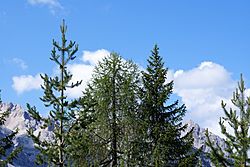Pinaceae facts for kids
Quick facts for kids Pinaceae |
|
|---|---|
 |
|
| Pinus, Larix and Abies side by side. | |
| Scientific classification | |
| Kingdom: | |
| Division: | |
| Class: | |
| Order: | |
| Family: |
Pinaceae
|
| Genera | |
|
Subfamily Pinoideae |
|
Pinaceae, also known as the pine family, is a group of trees and shrubs. This family includes many well-known conifers. You might recognize some of them like cedars, firs, hemlocks, larches, pines, and spruces. Many of these trees are important for their wood.
The pine family belongs to a larger group called Pinales. Scientists agree that all trees in the Pinaceae family share a common ancestor. This makes them a "monophyletic" group. It is the largest living conifer family based on the number of different species. There are between 220 and 250 species in 11 different groups (genera). It is also the second-largest family in terms of where its members grow around the world.
Contents
Where Do Pine Trees Grow?
Pine family trees are found mostly in the Northern Hemisphere. Most species prefer cooler, temperate climates. They often make up a big part of forests in cold areas (like the boreal forests), along coasts, and in mountains. Just one species crosses the equator into Southeast Asia. You can find many different types of these trees in the mountains of southwest China, Mexico, central Japan, and California.
What Are Cones and How Do They Help Trees?
Cones are a special part of conifer trees. They help the trees reproduce. You might see two main types of cones on a pine tree:
- Seed cones: These are the larger, woody cones you usually pick up. They contain the seeds.
- Pollen cones: These are smaller and softer. They produce pollen, which is like a fine powder.
The pollen from the pollen cones travels to the seed cones. This helps the seeds grow inside the seed cones. Once the seeds are ready, the cones open up and release them. This allows new trees to grow.
Different Cone Shapes and Sizes
Cones come in many shapes and sizes, depending on the type of tree. For example, a European black pine has cones with a small bump called an "umbo." But a Norway spruce cone does not have this bump. Looking closely at cones can help you tell different pine family trees apart.
Images for kids
-
Cultivated pine forest in Vagamon, southern Western Ghats, Kerala, India
See also
 In Spanish: Pináceas para niños
In Spanish: Pináceas para niños






